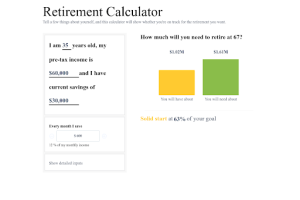Retirement planning is arguably the most crucial long-term financial goal for most Americans. With an average life expectancy increasing and the traditional pension fading, the responsibility for securing a comfortable retirement falls squarely on individual shoulders. Yet, many U.S. residents feel overwhelmed, wondering how much they truly need to save. This is where a retirement savings calculator becomes an indispensable tool for smart money saving.
Far from being just a simple number cruncher, these calculators offer invaluable insights, helping you visualize your financial future, set realistic goals, and stay on track. Let’s explore why a retirement savings calculator is essential for every U.S. resident’s financial planning.
Why You Need a Retirement Savings Calculator
Navigating the complexities of long-term investing, inflation, and future expenses can be daunting. A retirement savings calculator simplifies this by:

- Setting Realistic Goals: It helps you move beyond vague aspirations and pinpoint a concrete savings target.
- Revealing Your “Magic Number”: Based on your inputs, it estimates the lump sum you’ll need to accumulate by retirement to support your desired lifestyle.
- Illustrating the Power of Compound Interest: See how even small, consistent contributions can grow significantly over decades, thanks to the magic of compounding.
- Highlighting the Cost of Delay: These calculators vividly demonstrate how delaying saving by even a few years can dramatically increase the amount you need to save later.
- Factoring in Inflation: They adjust for the eroding power of inflation, ensuring your future retirement income has the same purchasing power as today’s dollars.
- Allowing “What If” Scenarios: Easily adjust variables like retirement age, contribution amounts, or investment returns to see how different choices impact your outcome.
- Benchmarking Your Progress: Compare your current savings to recommended guidelines. For instance, Fidelity suggests aiming for 1x your salary by age 30, 3x by age 40, 6x by age 50, and 8x by age 60, with 10x by age 67.
Key Information to Input into a Retirement Savings Calculator
To get the most accurate projection, be prepared to enter the following information:
- Current Age: Your age now. The younger you are, the more time your money has to grow.
- Desired Retirement Age: When do you envision stopping full-time work? (Many calculators use age 65 or 67 for Social Security Full Retirement Age).
- Current Retirement Savings: The total balance across all your retirement accounts (401(k)s, IRAs, etc.). As of mid-2025, median retirement savings in the U.S. for those aged 35-44 is around $45,000, rising to $185,000 for those 55-64.
- Annual Income: Your current gross (pre-tax) income.
- Expected Annual Income Growth: A percentage to account for raises over your career.
- Current Annual Retirement Contributions: The total amount you (and your employer, if applicable) contribute to retirement accounts each year, typically as a percentage of your salary. Financial advisors often recommend saving 10-15% of your pre-tax income for retirement.
- Desired Retirement Income/Expenses: What percentage of your pre-retirement income do you expect to need in retirement? (A common rule of thumb is 70-80%). Alternatively, you can input an estimated annual dollar amount of expenses you expect in retirement.
- Expected Rate of Return (Pre-Retirement): The average annual growth you anticipate from your investments before retirement (e.g., 6-8% is often used for a diversified portfolio).
- Expected Rate of Return (During Retirement): The average annual growth you anticipate from your investments during retirement, as your portfolio might shift to more conservative assets.
- Inflation Rate: The average rate at which prices are expected to rise (e.g., 2.5-3%).
- Social Security Benefits: An estimate of your future Social Security benefits (you can get this from the Social Security Administration website).
- Other Income Sources: Any pension, part-time work income, or other revenue you expect in retirement.
Where to Find Reputable Retirement Savings Calculators (U.S.)
Many financial institutions and reputable financial planning websites offer excellent, free retirement calculators:

- Vanguard Retirement Income Calculator: Known for its user-friendly interface and focus on investment-centric planning.
- Fidelity Retirement Calculator: Provides comprehensive tools and often offers personalized insights based on your inputs.
- T. Rowe Price Retirement Calculator: Features robust scenario testing and a clear breakdown of results.
- Charles Schwab Retirement Calculator: Allows for easy input of personal and retirement plan details to gauge your readiness.
- Bankrate Retirement Calculator: A popular choice for its straightforward interface and detailed output summary.
Interpreting Your Results and Taking Action
Once you’ve used a calculator, you’ll likely receive a projection of whether you’re on track, ahead, or behind. Don’t be discouraged if you’re not perfectly on target; the calculator’s purpose is to guide your actions.
If you’re behind:
- Increase Contributions: Even a small percentage increase can make a big difference over time.
- Delay Retirement: Working a few extra years allows for more savings and fewer years needing to draw from your nest egg.
- Adjust Spending Habits: Look for ways to reduce current expenses and reallocate those savings to retirement.
- Invest More Aggressively (Cautiously): Consider adjusting your asset allocation, but understand the increased risk involved.
- Explore Catch-Up Contributions: If you’re age 50 or older, the IRS allows you to make additional “catch-up” contributions to 401(k)s and IRAs.
If you’re on track or ahead:
- Maintain Momentum: Keep up your consistent contributions.
- Consider Early Retirement: If that’s a goal, your projections might show it’s feasible.
- Review Your Plan Annually: Life changes (salary increases, market fluctuations, family events) can impact your projections. Regularly revisit your calculator to stay on course.
Conclusion
A retirement savings calculator is more than just a financial tool; it’s a powerful motivator and a roadmap for your future. For U.S. residents, understanding your retirement needs and actively planning for them is paramount to achieving financial security and peace of mind.
By inputting your data, experimenting with different scenarios, and consistently contributing to your retirement accounts, you gain clarity and confidence in your long-term financial strategy. Don’t leave your retirement to chance. Utilize a retirement savings calculator today to transform your aspirations into an actionable plan, ensuring you’re well on your way to a comfortable and fulfilling retirement.










